-

Vizio V-Series
Best overall budget TV
$330 at Best Buy
Price alerts on for Vizio V-Series
-

TCL 4-Series Roku TV
Best budget TV runner-up
$300 at Best Buy
-

Hisense A6H Google TV
Best design in a budget TV
$248 at Amazon
Price alerts on for Hisense A6H Google TV
-

Fire TV 4-Series
Best budget TV for brightness
$470 at Amazon
-

NEW! CNET Shopping Extension
Get the lowest price on everything
Add CNET Shopping
Not everyone wants to spend many hundreds or even thousands of dollars on a new TV. In fact,the first step in the process of purchasing a new TV often involves figuring out your budget. CNET’s list of best TVs is full of models that feature QLED, mini-LED or OLED screen technology – advancements that enhance picture quality but also significantly increase the price.
So we’ve set out to find great entry-level TVs that don’t break the bank, but still have plenty to offer. These units won’t win any awards for brightness or picture enhancements and that’s OK. Entry-level TVs aren’t super fancy, but they can bring a surprisingly clear and balanced picture at a more palatable price.

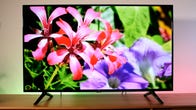
Watch this:
Best Entry-Level TVs of 2022
8:49
In fact, most models in this range have more similarities than differences. All use LCD panels with a 60Hz native refresh rate, offer 4K resolution and HDR playback and come with smart TV streaming built-in. Differences in brightness, the color quality of the screen, the type of HDR format, extra features (such as for gaming, among other things) and the usefulness of the smart platform help certain models stand out.
For this roundup, CNET editor David Katzmaier and I tested four 2022 budget TVs side by side in CNET’s TV lab. We focused on 50-inch models because they fit well in many different kinds of spaces, but are significantly less expensive than their big-screen counterparts. That said, these TVs come in a range of sizes, usually between 43 inches and 75 inches. Specifications for other sizes in the same series are generally identical, and we expect similar image quality from every size.

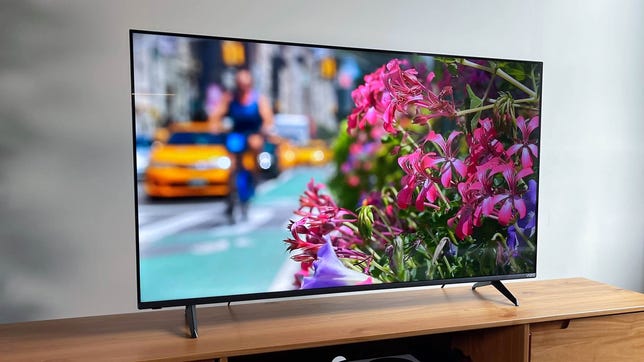
David Katzmaier
Vizio V-Series
Best overall budget TV
For picture quality alone, the Vizio V-Series clearly emerged as the leader of the pack. The Vizio offered the most balanced and accurate picture during our side-by-side comparisons, and it comes with some useful extras such as Dolby Vision support, Wi-Fi 6E, Bluetooth compatibility and variable refresh rate for potentially smoother gaming. The biggest downside of the Vizio is its smart TV platform, Vizio SmartCast. It’s crowded, slow and littered with ads for platforms such as Tubi and Kidoodle TV.
Ultimately, the Vizio V-Series offers the best picture, along with some high-quality extras at an extremely affordable price, even when you factor in the cost of adding a new streaming device. This is more than enough to make it the best overall entry-level TV that I tested.
Sizes: 43-inch, 50-inch, 55-inch, 58-inch, 65-inch, 70-inch and 75-inch. The price below is for the 50-inch model.
$330 at Best BuyGet Price AlertsYou’re receiving price alerts for Vizio V-Series

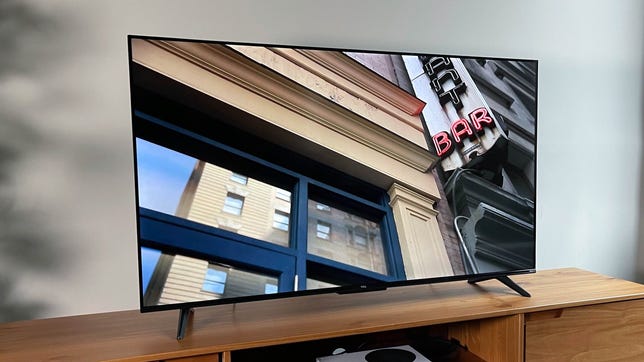
David Katzmaier
TCL 4-Series Roku TV
Best budget TV runner-up
The picture quality of the TCL 4-Series Roku TV was only a slight step behind the Vizio in our testing. The black levels and picture accuracy of the TCL might not be quite as deep and rich as the Vizio, but are still quite good. The differences between the two are slight enough that you’d really have to have them set up side by side to notice anything at all. The 4-Series lacks the Dolby Vision, Bluetooth connectivity and AMD FreeSync with a variable refresh rate, all of which the Vizio offers. However, it does come with the excellent Roku Smart TV system built in.
The TCL 4-Series is a great entry-level option for most people and could be a great purchase for those who prefer the Roku system and are looking for a one-stop smart TV solution.
Sizes: 43-inch, 50-inch, 55-inch, 65-inch, 75-inch, 85-inch. The price below is for the 50-inch model.
$300 at Best Buy

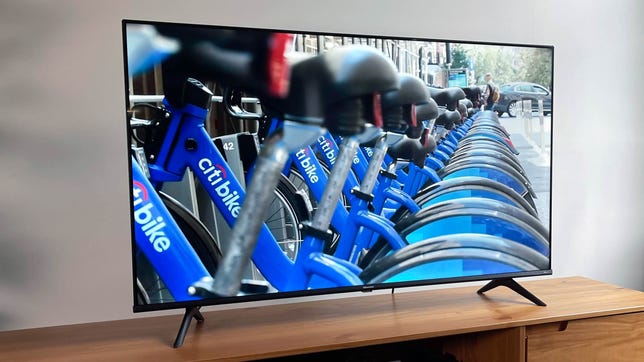
David Katzmaier
Hisense A6H Google TV
Best design in a budget TV
The Hisense A6H Google TV, like the Vizio, offers some higher-end features at the entry-level price. This TV features a premium build quality and comes with Dolby Vision support, Bluetooth connectivity and DTS Virtual:X for simulated surround sound. The Hisense A6H comes preloaded with Google TV – which is our second favorite after the Roku platform – but we found it ran slower than Google TV on higher-end TVs like the Sony X80K.
Although its image quality falls short of the TCL and Vizio, the A6H also stands out from the pack in design. The bezels on the TV are incredibly thin, and the display itself attaches directly to the back of the panel, leaving corners that are round and metallic. This gives the TV a more premium finish that I did not see with other units in this price range.
Ultimately, the Hisense A6H Google TV is a good choice for budget buyers who appreciate its design and want the Google TV interface.
Sizes: 43-inch, 50-inch, 55-inch, 65-inch, 70-inch, 75-inch. Prices below are for the 50-inch model.
$248 at Amazon$290 at Best Buy$290 at TargetYou’re receiving price alerts for Hisense A6H Google TV

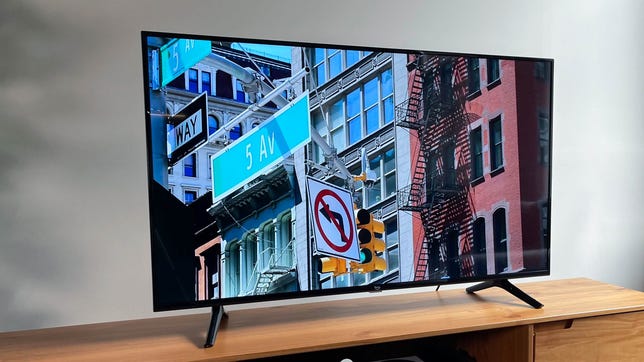
David Katzmaier
Fire TV 4-Series
Best budget TV for brightness
The Fire TV 4 Series is one of the most basic TVs on this list. It doesn’t offer Dolby Vision or any perks for gamers, like AMD FreeSync, and it also lacks the impressive build quality of the Hisense. Instead, the Fire TV gives you a brighter image, an Alexa-powered voice remote and access to Amazon content.
The Fire TV 4-Series offers the brightest screen and the best picture for gaming out of our entry-level models, but we liked its smart TV system least of all. That said, it could be a good fit for people with bright rooms or those who are tied into the Amazon ecosystem.
Sizes: 43-inch, 50-inch, 55-inch. The price below is for the 50-inch model.
$470 at Amazon
The picture quality of entry-level TVs isn’t amazing, but better than you think

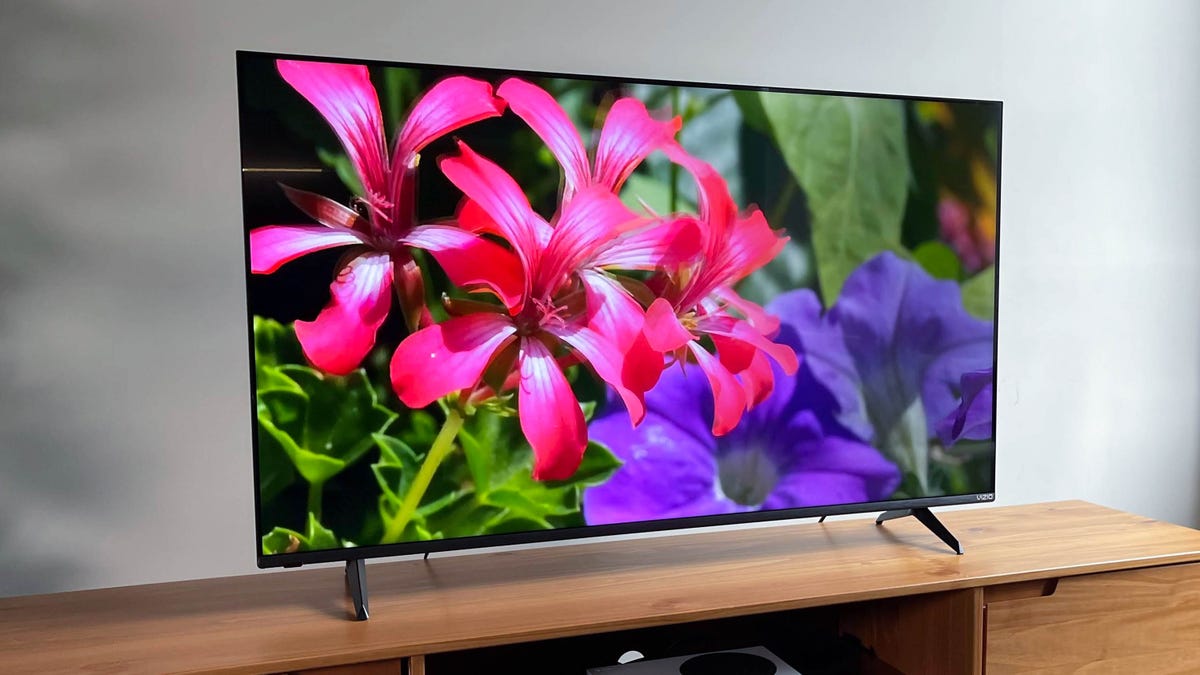
The picture on the Vizio V-Series is better than you would think.
David Katzmaier
Entry-level TVs lack mini-LEDs, local dimming zones and other technology that can really make a TV screen pop. When comparing these TVs in the lab, it was sometimes hard to differentiate between standard definition and 4K, as well as between standard dynamic range and HDR – as both kinds of content tended to look similar.
That said, the picture accuracy on the V-Series was clearly a step ahead of the pack. Colors appeared more accurate and levels looked darker, which gives the V-Series slightly more contrast than the other TVs on this list. Watching episodes of The Crown on Netflix, for example, the shadows in a dimly lit room looked more realistic than they did on many of the other TVs. Additionally, I could distinguish more of the details in the folds of a man’s suit, while the skin tones of the people on screen looked decidedly more natural than those on the red-leaning TCL and the blue-leaning Fire TV.
On the TCL, the blacks of the opening credits in season 2 looked rich and dark, and I could make out most of the details in the suit of the man in the beginning of episode 5. The skin tone of the queen and Philip appeared slightly redder than on the Vizio, especially during the scene where the queen gives a speech in a red dress in front of a red background. This pink tint continued when I adjusted the TV for brighter environments, and I never managed to find a picture setting that worked as well as the Calibrated mode on the Vizio.

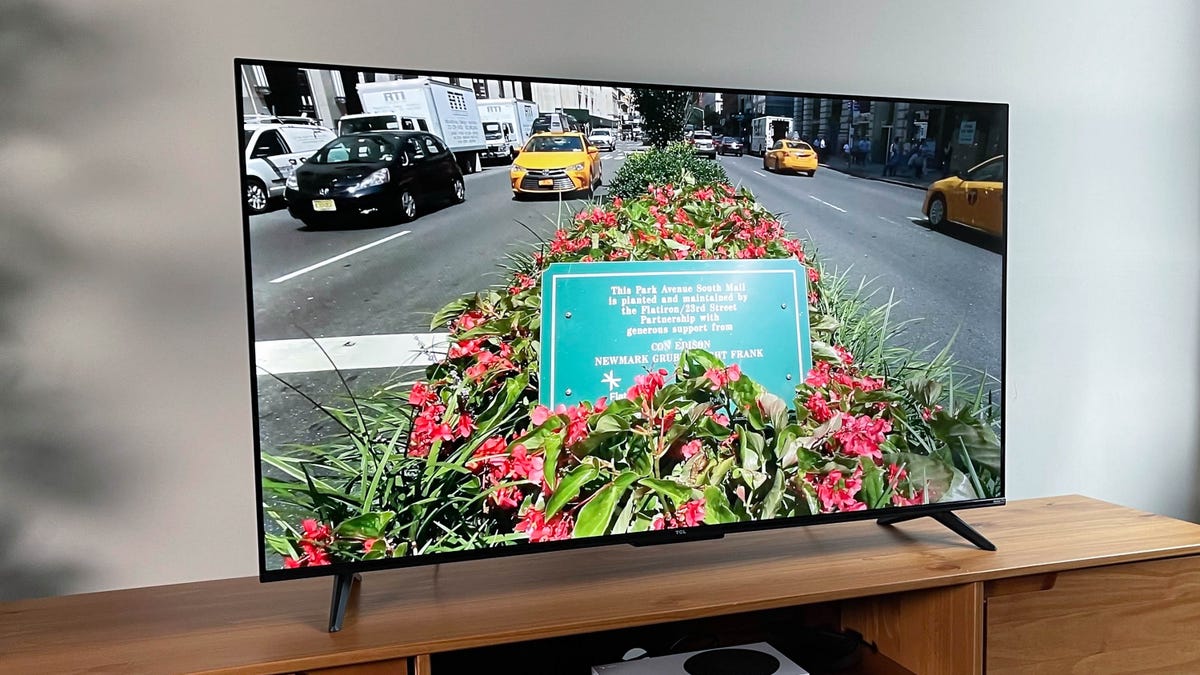
The TCL 4-Series looks almost as good as the Vizio.
Sarah Lord/CNET
The TCL’s picture settings give you plenty of control, but it’s sometimes difficult to find the best combination for the most accurate picture. In a dark room I used Dark HDR and coupled it with the Dark brightness setting. I found that it was hard to get a good combination in lighter rooms and that the process was needlessly tricky and time-consuming.
The Hisense falters compared to the other two. Colors looked muted and less vivid, blacks low-contrast and washed-out. In The Crown, colors of the objects failed to pop, and the blacks had more of a grayish tone. Similarly, it was difficult to make out many of the details of a dark suit. The skin tones had a pale, bluish tint to them, and the TV as a whole skewed toward blue colors. Filmmaker mode, which tends to be the most accurate, failed to rectify these issues in light or dark environments.
The Fire TV 4-Series also showed weak contrast when adjusted for a dark room, and only got worse when I turned up the brightness for bright rooms. The opening credits of The Crown revealed a grayish-blue tint in the sections that should be completely black. It was also difficult to make out details in dark suits and in scenes that are not well lit. Skin tones on the queen and Philip tended to look a little blue, as the entire display again leans heavily toward bluer hues.
Entry-level TVs aren’t very bright, but are serviceable

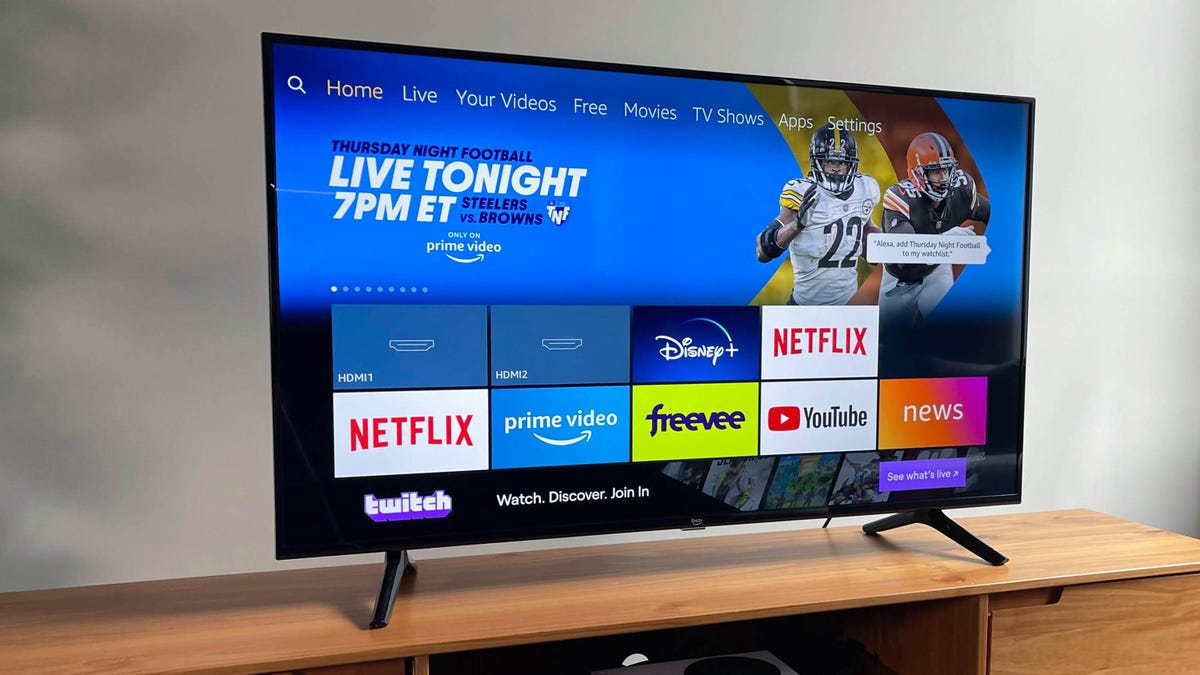
The Amazon Fire 4-Series offered the brightest picture.
David Katzmaier
The Vizio performed well under bright conditions. The Calibrated picture setting, which is best used for an accurate picture in light-filled rooms, only yields an average of 215 nits of brightness. That was one of the lowest brightness levels I measured, but numbers aren’t everything, and the Vizio certainly passed the eye test. It turns out that I wasn’t able to discern much of a real-world difference in brightness when actually watching shows on the TV. The Vizio was absolutely bright enough for a well-lit room and was able to maintain its serviceable blacks and accurate color during light-filled viewing sessions.
The Roku’s screen looked sufficiently bright in a dark room as well as a light-filled one. It averaged 226 nits of brightness in the Brighter setting on Dark HDR, which isn’t particularly bright. This screen, like the Vizio’s, isn’t going to wow you with its light output. However, it’s more than bright enough for you to watch any show in any lighting environment.
The brightness levels on the Hisense were about average for the TVs on this list at 247 nits in HDR Theater mode. Even so, it was certainly bright enough to watch comfortably in any lighting conditions.
The Fire TV 4 Series was by far the brightest that I tested, with an average reading of 312 nits in Movie mode. In this case, the numbers actually bear out a real-world result, as the TV looked noticeably brighter than the rest of the lineup in our side-by-side testing.
The numbers above don’t get much brighter in less-accurate modes on these TVs, and to get significantly brighter images you’ll need to pay more. Among 2022 TVs we’ve reviewed, the 55-inch Samsung QN60B measured 514 nits in its most accurate mode while the 65-inch Vizio MQX measured 742 nits (and Vizio claims the 50-incher hits 400).
Yes, you can play video games on entry-level TVs

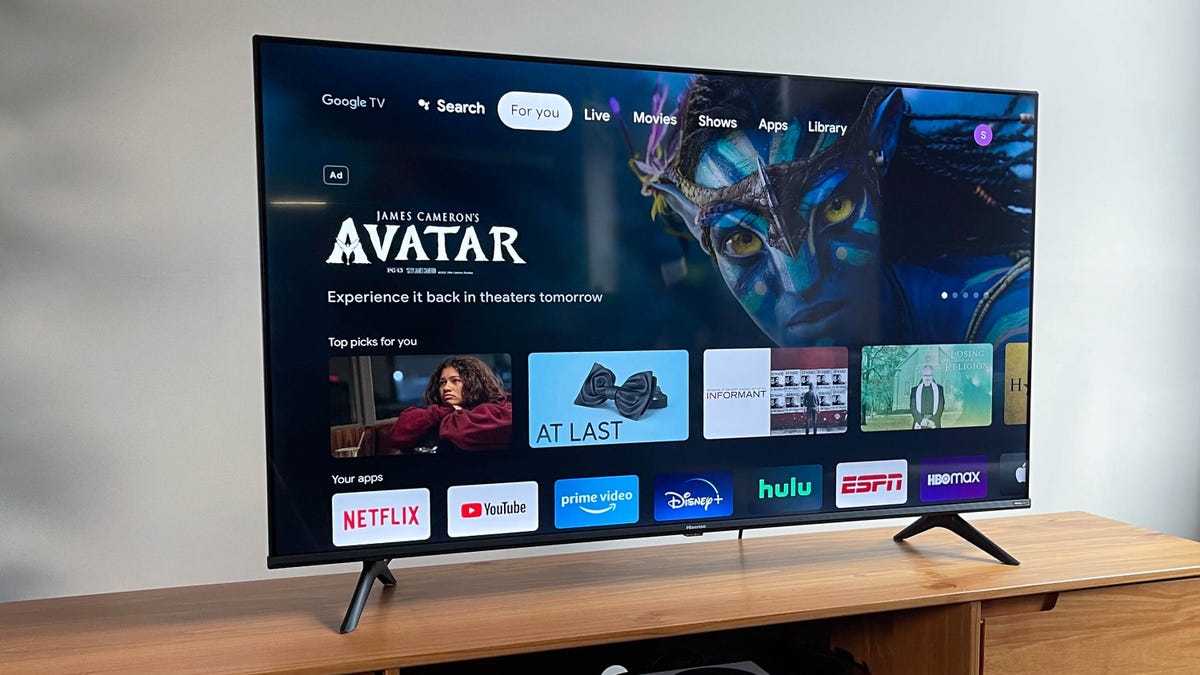
You can play video games on entry-level TVs, but game mode isn’t always visually pleasing.
David Katzmaier
Gaming on the Vizio was an adequate experience, though I found the picture when playing Call of Duty on the Xbox Series X to be less vivid and more washed-out than some of the others in gaming mode. The Vizio is the only entry-level TV on this list to offer AMD FreeSync and a variable refresh rate. The frame rate never dropped below 60 frames per second, according to Vizio’s display when I was playing, so I never saw the variable refresh rate in action. Of course, your results may vary.
The TCL 4-Series display managed to look particularly bright while playing video games. Call of Duty looked crisp and vivid, if a little on the blue-tinted side of the color spectrum. While the 4-Series isn’t known for any gaming-specific enhancements, the TV managed to deliver a more than adequate gaming experience for the average gamer.
CoD on was not a ton of fun on the Hisense. There was a lack of color accuracy in Gaming Mode – landscapes were tinted bluish-green, and nighttime sequences lacked contrast and detail. Casual gamers might not notice much of a difference, but those who game regularly might be disappointed by the picture in their games.
The brightness levels on the Fire TV 4 Series actually made a positive impact while gaming, and Call of Duty looked best on the Fire TV in our side-by-side testing. The game appeared vivid and enticing while playing with Game Mode turned on. Landscapes were still tinted slightly blue, but I was able to make out all the details of the streets as I raced after an enemy in the black of night.
Some built-in smart TV systems are better than others

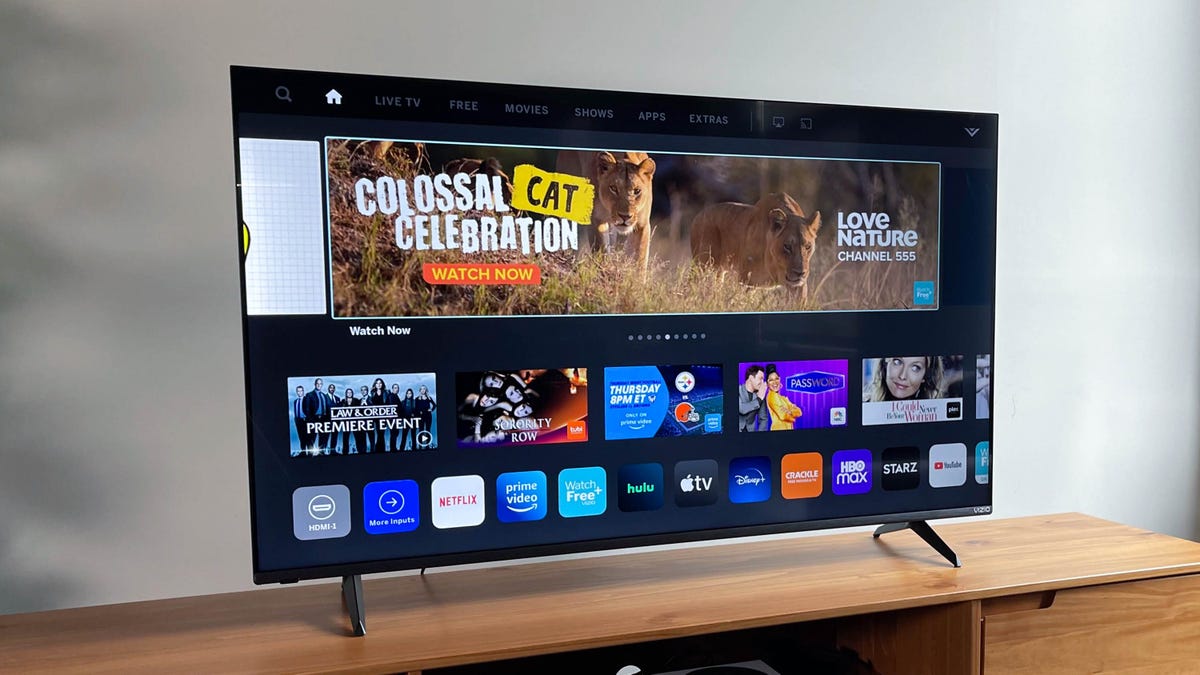
The Smart TV platform on the Vizio isn’t all that great.
David Katzmaier
As with any TV it’s easy enough to switch out your smart TV platform by purchasing a separate streaming device, starting at $40 for an excellent Roku with 4K HDR, and many streamers go on sale during the holidays. Of course you can save that money and use the system built into your TV.
The Roku platform is my favorite, and Roku on the TCL 4-Series worked very well. Apps on the TCL launch quickly, and Roku features an uncluttered, easy-to-use approach that doesn’t recommend any streaming service over any other. It also has the simplest interface along with the best search functionality, which our test demonstrated.
The TCL lacks the on-remote voice control found on the other TVs, but Roku’s robust software comes with an easy-to-use phone app for iOS and Android that can be used as a remote for your TV. The app does come with voice control and allows you to tap into Roku’s best-in-class search features. For example, Netflix launched immediately when I spoke into my phone. Similarly, Roku easily handled my request for The Case Against Adnan Syed. Clicking on the result gave me a list of everywhere the series was playing and how much it would cost to watch it. Saying “football” into the phone brings up upcoming games, along with sports movies included with my Disney Plus subscription. Searching for the Steelers actually showed Pittsburgh Steelers games.

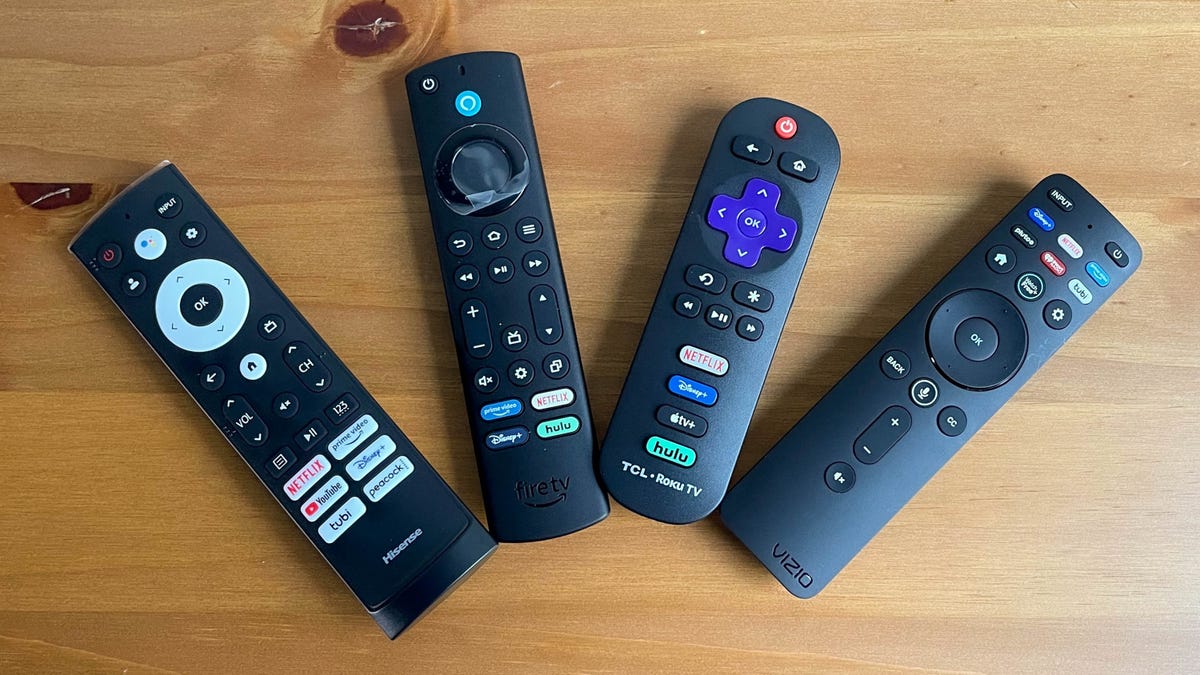
Every TV comes with a simple and usable remote.
Sarah Lord
Despite being my favorite budget TV, the Vizio has my least-favorite smart TV platform.
The screen is cluttered with shows and movies, and below the row of apps there are many other rows including “Live TV and On Demand,” “New on Hulu” and “Collections.” Navigating is noticeably sluggish, and using the voice search feature on your remote might actually be faster. For example, Netflix came right up when I asked, as did The Case Against Adnan Syed. Vizio also told me which services had the show, which I thought was a nice touch.
I wasn’t so lucky when I searched for football, which yielded zero results. Saying “Steelers” into the mic only brought up a movie about the world’s first gay rugby club. This is particularly hard to take given that Vizio’s home screen featured a large advertisement for a Steelers vs. Browns football game. It looks like Smart Cast needs to get a little smarter.

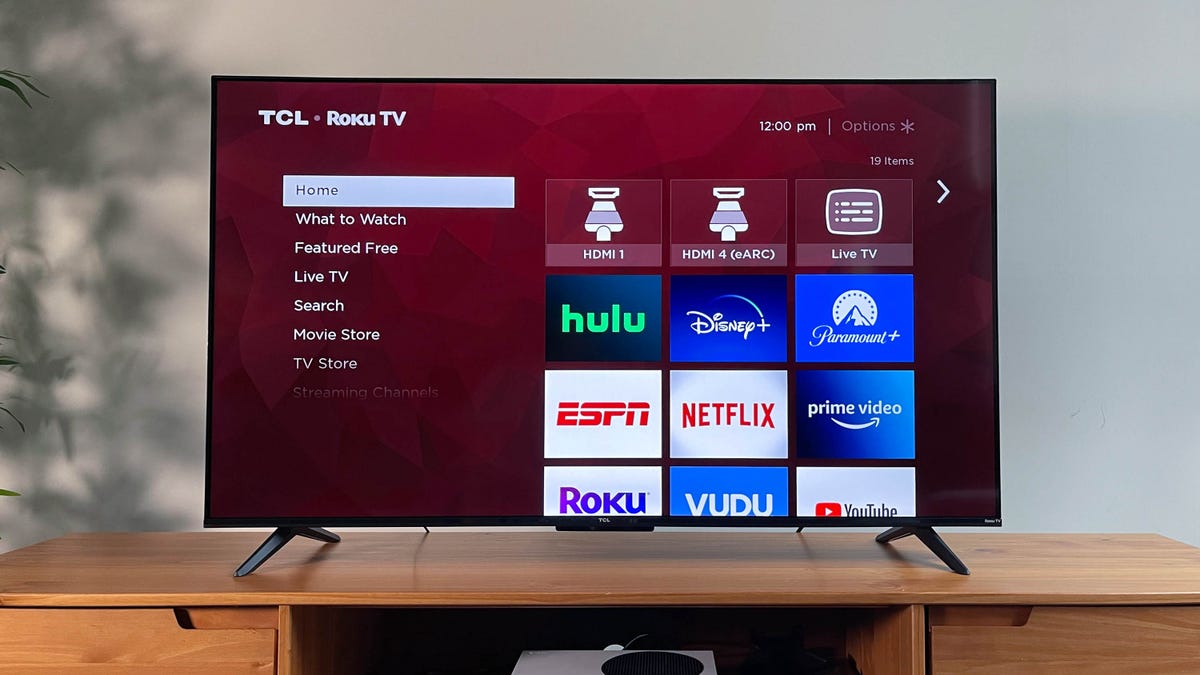
The Roku TV platform is my favorite.
David Katzmaier
The Hisense A6H comes with Google TV and includes Google Assistant built into the remote. The remote eventually worked well, but I had some trouble initially trying to pair it to the TV. You’ll need to make sure to pair the remote manually with Bluetooth in order to get Google Assistant working properly.
I know that some people absolutely love the Google TV interface and find it more useful than Roku’s, but I found it to be slow on this particular TV. Google also offered up some silly categories that made little sense. For example, a category called Love Dramas appeared on my screen. I’m not sure if Google thought I loved watching dramas or if I was interested in dramas about love, but scrolling through the offerings didn’t bring much clarification. The category included Baz Luhrmann’s classic Romeo + Juliet, but with a poster that incorrectly identified it as Romeo & Julia, along with the movies The Florida Project and Sweeney Todd – both of which can only tangentially be related to love and then only in the darkest of senses.
Google Assistant swiftly took me to Netflix when I asked, and automatically opened HBO Max when I wanted The Case Against Adnan Syed. Asking for football gave me football-related YouTube videos and a few football movies, but no actual games. Searching for the Steelers also failed to yield any games.

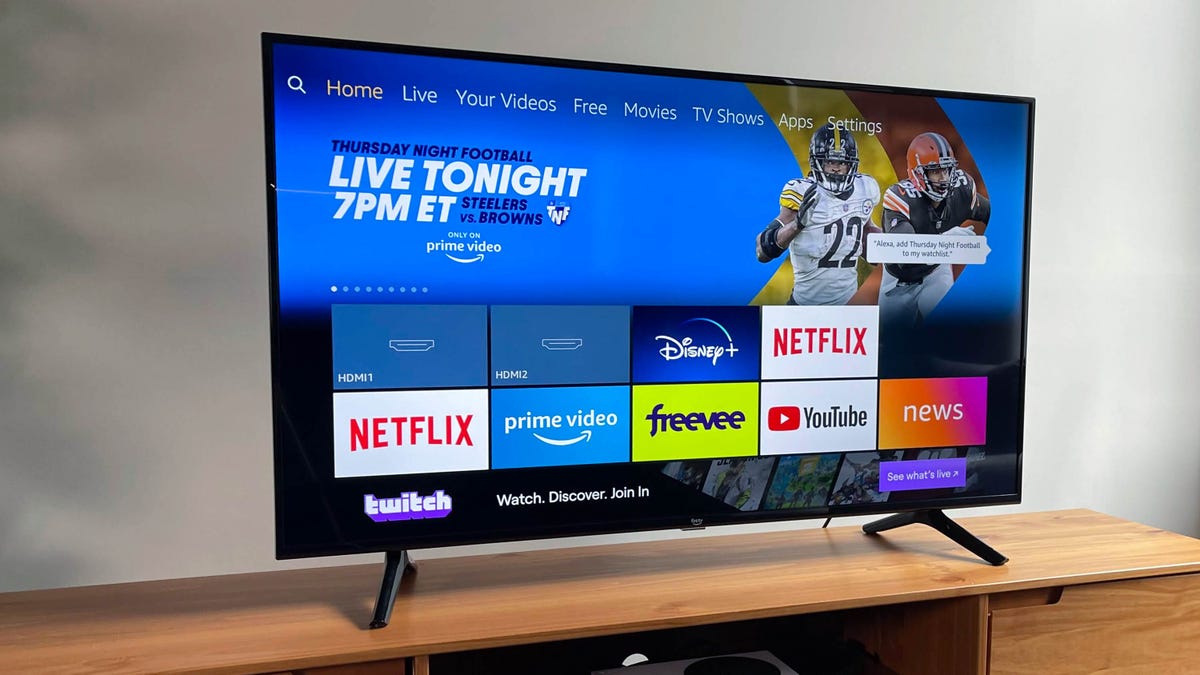
The Fire TV works well with Alexa.
David Katzmaier
As you would expect, the Fire TV 4-Series worked well with Alexa integration. Netflix immediately popped up on the screen when I asked Alexa to open it. It took a little more time to process my request for The Case Against Adnan Syed but eventually showed me that I could watch it on HBO Max or purchase episodes from Amazon. Asking Alexa for football yielded results that included live events for both soccer and American football, along with football-related movies and TV shows.
The Fire TV interface was cluttered with both content and ads, with categories that include “Movies and TV” and “Trending on Fire TV.” Many of these categories promote content that is available exclusively through Amazon Prime Video. I don’t love it when ads are featured prominently throughout a platform, as they are here, and I especially don’t appreciate it when the TV becomes a giant rotating billboard for content or ads when it’s in screensaver mode.
How does CNET test budget TVs?
For this roundup, four similar TVs were compared side by side, using an AVPro Connect 8×8 4K HDR distribution matrix, in various lighting conditions, and playing different media, including movies, TV shows and games, across a variety of test categories, from brightness to video processing to gaming to HDR. I did not perform CNET’s standard suite measurements or Geek Box tests for this group of TVs, although I did measure input lag for gaming as well as brightness in nits using a Konica Minolta LS-100 luminance meter. Our evaluations also account for design, features, smart TV performance, HDMI input and gaming compatibility and other factors.
Entry-level TVs FAQ
Are cheap TVs worth it?
In general, the answer is yes.
Of course, everyone has different needs, but cheap TVs offer a totally fine viewing experience for most people. You’re obviously not going to get the absolute best in picture quality or features in an entry-level TV, but your you will get a TV with decent picture quality that will last for years.
Will TV prices drop?
Yes, they will.
The TV buying cycle is cyclical. Each year, new TVs are announced in January, before hitting the shelves in the spring and early summer. They then go on sale during the fall and into Black Friday, where they typically hit their lowest prices, as manufacturers try to clear out inventory for the new models coming out in January.
That said, entry-level TVs are already pretty cheap to begin with, so discounts don’t tend to be as large as those on more expensive models.
Are smaller TVs always cheaper?
Not always, but usually. Larger TVs of the same brand and series are almost always more expensive than smaller ones.
Of course, pricing largely depends on the type of TV you’re hoping to get. For example, you’ll certainly be able to find a larger TV from a budget brand with basic features that costs less than a smaller high-end TV. The difference in price in this instance is most likely based on the varying types of technology used in the two TVs.
It’s generally a good idea to first determine the size of the TV you want and then come up with a budget for the purchase. This allows you compare all the various models in your budget and price range, so that you can find the best TV for you.
